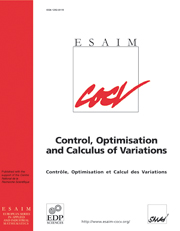Crossref Citations
This article has been cited by the following publications. This list is generated based on data provided by
Crossref.
Bonnard, B.
and
Janin, G.
2008.
Geometric Orbital Transfer Using Averaging Techniques.
Journal of Dynamical and Control Systems,
Vol. 14,
Issue. 2,
p.
145.
Bonnans, F.
Martinon, P.
and
Trélat, E.
2008.
Singular Arcs in the Generalized Goddard’s Problem.
Journal of Optimization Theory and Applications,
Vol. 139,
Issue. 2,
p.
439.
Bonnard, B.
Chyba, M.
and
Sugny, D.
2009.
Time-Minimal Control of Dissipative Two-Level Quantum Systems: The Generic Case.
IEEE Transactions on Automatic Control,
Vol. 54,
Issue. 11,
p.
2598.
Bonnard, Bernard
and
Sugny, Dominique
2009.
Time-Minimal Control of Dissipative Two-Level Quantum Systems: The Integrable Case.
SIAM Journal on Control and Optimization,
Vol. 48,
Issue. 3,
p.
1289.
Caillau, J.-B.
Daoud, B.
and
Gergaud, J.
2010.
Recent Advances in Optimization and its Applications in Engineering.
p.
205.
Silva, Cristiana
and
Trelat, Emmanuel
2010.
Smooth Regularization of Bang-Bang Optimal Control Problems.
IEEE Transactions on Automatic Control,
Vol. 55,
Issue. 11,
p.
2488.
Silva, C.
and
Trélat, E.
2010.
Asymptotic approach on conjugate points for minimal time bang–bang controls.
Systems & Control Letters,
Vol. 59,
Issue. 11,
p.
720.
Bonnard, B.
Cots, O.
Shcherbakova, N.
and
Sugny, D.
2010.
The energy minimization problem for two-level dissipative quantum systems.
Journal of Mathematical Physics,
Vol. 51,
Issue. 9,
Rapaport, Alain
and
Dochain, Denis
2011.
Minimal Time Control of Fed-Batch Processes With Growth Functions Having Several Maxima.
IEEE Transactions on Automatic Control,
Vol. 56,
Issue. 11,
p.
2671.
Bonnard, Bernard
Shcherbakova, Nataliya
and
Sugny, Dominique
2011.
The smooth continuation method in optimal control with an application to quantum systems.
ESAIM: Control, Optimisation and Calculus of Variations,
Vol. 17,
Issue. 1,
p.
267.
Caillau, J.-B.
Cots, O.
and
Gergaud, J.
2012.
Differential continuation for regular optimal control problems.
Optimization Methods and Software,
Vol. 27,
Issue. 2,
p.
177.
Caillau, J.-B.
and
Daoud, B.
2012.
Minimum Time Control of the Restricted Three-Body Problem.
SIAM Journal on Control and Optimization,
Vol. 50,
Issue. 6,
p.
3178.
Trélat, E.
2012.
Optimal Control and Applications to Aerospace: Some Results and Challenges.
Journal of Optimization Theory and Applications,
Vol. 154,
Issue. 3,
p.
713.
Bayen, Terence
Gajardo, Pedro
and
Mairet, Francis
2012.
Minimal time control of fed-batch bioreactor with product inhibition.
p.
579.
Caillau, J.-B.
Daoud, B.
and
Gergaud, J.
2012.
Minimum fuel control of the planar circular restricted three-body problem.
Celestial Mechanics and Dynamical Astronomy,
Vol. 114,
Issue. 1-2,
p.
137.
Picot, Gautier
2012.
Shooting and numerical continuation methods for computing time-minimal and energy-minimal trajectories in the Earth-Moon system using low propulsion.
Discrete & Continuous Dynamical Systems - B,
Vol. 17,
Issue. 1,
p.
245.
Bonnard, Bernard
Glaser, Steffen J.
and
Sugny, Dominique
2012.
A Review of Geometric Optimal Control for Quantum Systems in Nuclear Magnetic Resonance.
Advances in Mathematical Physics,
Vol. 2012,
Issue. ,
p.
1.
Bayen, Térence
and
Mairet, Francis
2013.
Minimal time control of fed-batch bioreactor with product inhibition.
Bioprocess and Biosystems Engineering,
Vol. 36,
Issue. 10,
p.
1485.
Bonnard, Bernard
Chyba, Monique
and
Marriott, John
2013.
Singular Trajectories and the Contrast Imaging Problem in Nuclear Magnetic Resonance.
SIAM Journal on Control and Optimization,
Vol. 51,
Issue. 2,
p.
1325.
Soledad Aronna, M.
Frédéric Bonnans, J.
and
Martinon, Pierre
2013.
A Shooting Algorithm for Optimal Control Problems with Singular Arcs.
Journal of Optimization Theory and Applications,
Vol. 158,
Issue. 2,
p.
419.


